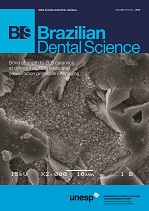Relationship of Oral Aesthetic Assessment according to Self Perception with Oral Malocclusion Condition of High School Students in Sidrap District, South Sulawesi Indonesia
DOI:
https://doi.org/10.14295/bds.2019.v22i4.1712Abstract
Self-perception of dental aesthetics needs to be considered in planning orthodontic treatment because it is known that everyone has a self-perception of different oral esthetic conditions. Objective: To assess the state of malocclusion based on self-perception of dental aesthetics using the Oral Aesthetic Subjective Impact Score (OASIS); to determine the relationship of self-perceptions of oral aesthetics and the state of malocclusion from the results of clinical examinations using the Dental Aesthetic Index (DAI). Material and Methods: Research subjects were middle school students aged between 14-18 years as many as 187 students. For oral aesthetic assessment using the OASIS index questionnaire, and to evaluate the aesthetic and anatomical components of the malocclusion clinic using the Dental Aesthetic Index (DAI). Results: The prevalence of malocclusion according to Dental Aesthetic Index (DAI) showed that mild / normal malocclusion (59.9%), moderate malocclusion (33.4%), severe malocclusion (5.7%), and very severe malocclusion (1%). The prevalence of self-perception of oral aesthetics was 54.6% judging good. The results of the analysis with logistic regression tests showed that there was a significant (p<0.001) relationship between self-perception of oral aesthetics using the OASIS index and malocclusion status using the DAI index. Conclusion: Based on the results of this study, there was a significant relationship (p <0.01) between oral aesthetic self perception and malocclusion status of high school students.
Keywords
Oral aesthetic perception; Oral aesthetic subjective impact score; Dental aesthetic index.
Downloads
Downloads
Additional Files
Published
How to Cite
Issue
Section
License
Brazilian Dental Science uses the Creative Commons (CC-BY 4.0) license, thus preserving the integrity of articles in an open access environment. The journal allows the author to retain publishing rights without restrictions.
=================




























